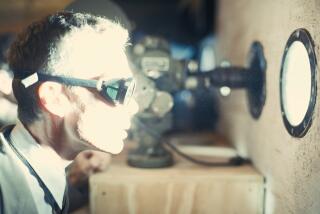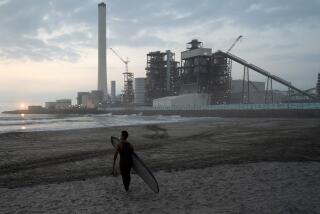Failure at U.S. Plant Similar to Chernobyl Would Not Be as Disastrous, Officials Say
- Share via
WASHINGTON — Simultaneous failure of primary and emergency cooling systems in a U.S. nuclear reactor similar to the devastated Chernobyl atomic power plant in the Ukraine would damage a third of its core and cause a partial meltdown but would not result in the kind of disaster that struck the Soviet Union, Energy Department officials said Wednesday.
The assessment, given to a House subcommittee and later challenged, was made as the department accelerated a technical evaluation of nuclear plants used to produce fuel for atomic warheads. The department also completed the formation of a panel of independent experts to review operations of the U.S. reactor most like the stricken Soviet plant.
Of most concern among U.S. reactors in the wake of the Soviet accident is the Energy Department’s N Reactor at Hanford, Wash. It, like the Chernobyl unit, uses graphite to moderate the neutron flux in its core and is without a reinforced concrete and steel containment vessel.
More Stringent Precautions
Appearing before the House Energy subcommittee on energy, conservation and power, department officials maintained that the similarities are outweighed by the more stringent U.S. safety precautions.
“Other than the use of graphite,” Assistant Energy Secretary Mary L. Walker said, “the N reactor bears little similarity” to the reactor at Chernobyl.
John Hunter, director of nuclear energy at the Energy Department’s Richland, Wash., operations office said studies show that the confinement building in which the N Reactor is housed would be adequate in case of an accident that resulted in a loss of coolant.
He acknowledged, however, that in the accident scenario used in the department study, it is assumed that cooling water would continue to flow to the graphite moderator. Another study is being conducted in an effort to forecast the effect of losing the coolant to the moderator as well, but Hunter said: “In my personal judgment as an engineer, it is not going to change things very much. . . . The flow of graphite cooling is very low.”
Hunter Challenged
Thomas B. Cochran, senior staff scientist for the Natural Resources Defense Council, who later testified before the panel, took issue with Hunter and other Energy Department representatives.
Cochran contended that the department’s reactors fail to meet the safety standards that the federal Nuclear Regulatory Commission requires of the commercial nuclear power industry, and he disputed the official projections of the effects of an accident at the N Reactor.
Meanwhile, Energy Secretary John S. Herrington named Louis H. Roddis, former president of Consolidated Edison Co. of New York, as chairman of an outside panel of experts to review the N Reactor design in light of the Chernobyl accident. Gerald Tape, a former member of the old Atomic Energy Commission, will be vice chairman.
Other members named Tuesday were Thomas H. Pigford, chairman of the nuclear engineering department at UC Berkeley, Eugene P. Wilkinson, the first commander of the first U.S. nuclear submarine; Miles C. Leverett, a nuclear consultant and former official of General Electric Co., and Harold W. Lewis, professor of physics at UC Santa Barbara.
Selections Criticized
Announcement of the panel drew sharp criticism from Democrats at the subcommittee hearing, led by Chairman Edward J. Markey (D-Mass.).
Markey charged that Roddis is “an industry spokesperson and part of the network that has to be overseen.” Tape, he said, has “a conflict of interest and a lack of objectivity.”
After several contentious exchanges with Walker, the congressman reiterated his view that “having DOE operate and regulate its facilities is intolerable.”
At the State Department on Wednesday, spokesman Charles Redman said the U.S. government still does not have sufficient information to fully evaluate the situation in the Ukraine. Indeed, he said, it is still unknown whether there is some problem with the No. 3 reactor at Chernobyl, which Pentagon officials once declared to have melted down or started a meltdown after the accident at No. 4.
The only remaining evidence of the Soviet accident to be found in the atmosphere over the United States on Wednesday were “patches” of radioactivity in the jet stream over New England. Earlier in the week, small amounts of radiation were detected in the Pacific Northwest.
None in California
The California Department of Health Services reported Wednesday that there were no readings of radioactivity in the air at any of its sites. But it did find traces of radioactivity in the rainfall at Eureka, although the amount “was so small that it was difficult to detect,” the department said.
Elsewhere in the country Wednesday, only Bismarck, N.D., reported a trace of radiation in ground material.
More to Read
Sign up for Essential California
The most important California stories and recommendations in your inbox every morning.
You may occasionally receive promotional content from the Los Angeles Times.










